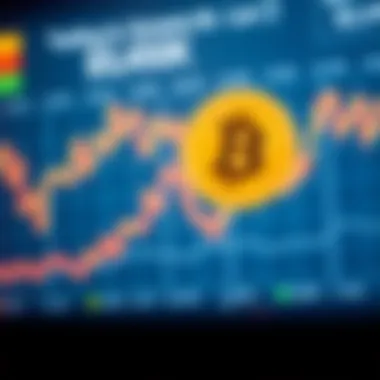Understanding Limit and Stop Orders in Crypto Trading


Intro
In today's fast-paced cryptocurrency market, traders must navigate a landscape filled with volatility and uncertainty. From Bitcoin to Ethereum, prices can swing wildly within minutes, making it essential for traders to utilize tools that provide precision in their trading strategies. Two of the most vital elements in this toolkit are limit orders and stop orders.
These orders are not just technicalities; they’re game-changers. By mastering the nuances between these order types, traders can seize opportunities, minimize losses, and time their entries and exits with impeccable accuracy. Whether you’re a seasoned investor or a newcomer to crypto, understanding the implications of each order can significantly influence your trading outcomes.
As we dive deeper into the subject, this article will illuminate the fundamentals of limit and stop orders, their respective strategic applications, and how market conditions and trader psychology play pivotal roles in their effectiveness.
Let's embark on this journey to sharpen our knowledge and enhance our trading prowess.
Prelims to Order Types
Navigating the volatile waters of cryptocurrency trading can often feel overwhelming, particularly for newcomers. One of the first steps to feel at home in this space is to comprehend the various order types available. Order types are the backbone of trading practices, governing how one buys and sells assets in this ever-shifting market. Recognizing the nuances in these orders, specifically limit and stop orders, is essential. By mastering these tools, traders can not only enhance their execution strategies but also mitigate potential losses.
Trading isn’t just about picking when to buy or sell; it’s also about establishing methods to automate certain aspects of transactions. Limit and stop orders empower traders to do just that. They provide specific conditions under which trades will be executed. This adds a layer of control over trade execution that can offer peace of mind in tumultuous market conditions. Moreover, understanding these order types can aid traders in crafting tailored strategies that align with their individual risk tolerance and investment goals.
"In trading, the aim isn’t merely making profits, but also managing risks effectively."
The importance of this topic cannot be overstated as the landscape of cryptocurrency is constantly evolving. As trends shift, so do the needs and preferences of traders. Thus, being adept in the use of various order types becomes a skill set that can significantly affect a trader’s success.
Understanding Market Orders
Market orders are typically the most straightforward type of order. When a trader places a market order, they're essentially indicating they're willing to buy or sell a cryptocurrency at the best available price at that moment. This means that execution is generally swift, making it suitable for those who prioritize speed over price precision. For instance, if a trader sees Bitcoin hitting a price of 20,000 and quickly wants to get a piece before it potentially rises further, a market order enables them to do just that.
However, there’s a catch; executing a market order can come with the risk of slippage—where the final execution price differs from the anticipated one due to instant price changes. This is particularly true in fast-moving markets popular in cryptocurrency trading, where price fluctuations can happen in a heartbeat.
Comparative Overview of Limit and Stop Orders
Understanding how limit and stop orders stack against each other brings clarity to the trading arsenal.
- Limit Orders: These orders allow traders to set a specific price at which they want to buy or sell an asset. They only execute if the market reaches that price. This can be an advantageous feature during unpredictable market conditions, as traders can wait patiently for the desired entry or exit point. For instance, if Litecoin is currently trading at 150 USD, a trader might set a limit order at 140, waiting for the price to dip lower before purchasing.
- Stop Orders: In contrast, stop orders act as a safety net. They become market orders once the price reaches a predetermined level—a stop price. For example, if a trader holds Ethereum at a price of 2,000 USD and wants to protect themselves from a downturn, they could set a stop order at 1,950 USD. Should Ethereum’s price dip and hit that point, the stop order triggers and sells to mitigate further losses.
In summary, while market orders prioritize immediacy, limit and stop orders offer precision and risk management. Traders who can differentiate between these orders and utilize them effectively can not only navigate the cryptocurrency market more effortlessly but also build resilience against its inherent unpredictability.
Defining Limit Orders
In the fast-paced world of cryptocurrency trading, limit orders stand as key instruments for achieving specific trading goals. At their core, limit orders allow traders to set a predetermined price at which they are willing to buy or sell a cryptocurrency. This ensures they don't end up making impulsive decisions based on sudden market movements. The basic premise behind defining a limit order is to provide traders with control over the transaction price, rather than allowing the market to dictate the terms of the trade.
While the mechanics might seem straightforward, the implications of limit orders can be profound. They not only help in achieving better pricing but also mitigate the emotional rollercoaster often present in trading environments. By utilizing limit orders, traders can establish a more disciplined approach, ensuring that strategy prevails over impulse.
Mechanics of Limit Orders
To grasp how limit orders operate, consider this scenario: you wish to buy Bitcoin but only if it drops to, say, $20,000. This is where the mechanics of limit orders come into play.
- You place a buy limit order for Bitcoin at $20,000. This means your order will only execute if the price hits that mark or goes lower.
- Conversely, should you hold Bitcoin and want to sell when it reaches $25,000, you'd place a sell limit order at that price.
The critical aspect here is timing; limit orders may not fill instantly or may not fill at all if the market price never reaches your limit. This dynamic gives traders the power to wait out price fluctuations—like fishing, where you toss the line and wait for the perfect catch.
Advantages of Using Limit Orders
Limit orders come with various advantages that can benefit both novice and seasoned traders. Here are a few notable perks:
- Price Control: As emphasized, limit orders let you decide the price at which you want to buy or sell. No surprises.
- Prevention of Emotional Decisions: By setting a defined entry or exit point, limit orders help in curbing the urge to react hastily to market swings.
- Strategic Planning: They fit neatly into trading strategies focused on specific market conditions, allowing for a more structured approach.


However, it’s essential to keep in mind that while these benefits can enhance your trading game, they shouldn’t be the sole tool in your arsenal.
Limit Orders in Volatile Markets
Cryptocurrency markets can swing wildly, exhibiting fierce volatility. In such environments, limit orders can either serve as a safeguard or become a double-edged sword. When prices fluctuate quickly, in-the-moment decisions often lead to missed opportunities or unanticipated losses.
Using limit orders in volatile conditions allows traders to maintain a clear view on price targets. For instance, if you’re eyeing an altcoin that has been increasing and you want to buy on a dip, setting a limit order could help capture that moment without the risk of pressing the buy button amid chaos. However, one has to be cautious; if the market moves too quickly past your limit, you might miss out.
Potential Limitations and Risks
While limit orders can streamline trading decisions, they are not without their drawbacks:
- Order May Not Execute: If a limit order is set too far from the current market price, it might never execute, leaving traders on the sidelines.
- False Sense of Security: Relying solely on limit orders might lead to complacency. Market dynamics can shift and invalidate your strategy.
- Partial Fills: Sometimes, only part of your limit order may get filled, which could be less than optimal depending on the size of your position.
Ultimately, understanding limit orders fully is pivotal for those looking to navigate the treacherous waters of cryptocurrency trading. Armed with this knowledge, traders can better craft their strategies and approach the market with increased confidence. For further information on cryptocurrency trading, visit Investopedia or check out communities like Reddit for discussions.
Understanding Stop Orders
In the realm of cryptocurrency trading, grasping the concept of stop orders is essential for anyone looking to navigate the often turbulent waters of the market. These tools are designed to mitigate risk while maximizing potential gains, and understanding how they function can lead to more strategic decision-making. Stop orders serve as automatic triggers to either sell or buy an asset once it reaches a predetermined price point, ensuring that a trader can exit or enter a position without having to monitor the market minute by minute. This empowerment allows traders to act confidently, even amidst market volatility.
Types of Stop Orders Explained
Within the world of stop orders, there are primarily two types that every trader should be acquainted with: stop-loss orders and stop-limit orders.
- Stop-loss Orders: This is a commonly used mechanism where a trader sets a specific price to sell an asset to prevent further losses. When the market price hits this threshold, the stop-loss order becomes a market order, selling the asset at the next available price. It's like putting on a parachute when you feel the plunge coming—an essential safeguard.
- Stop-limit Orders: A slightly more nuanced approach, a stop-limit order combines the features of stop-loss with a limit order. When the designated stop price is triggered, a limit order is placed at a specific price that the trader determines. This type of order can avoid selling at a less favorable price but comes with the risk of not executing at all if the market moves too quickly.
Strategic Uses of Stop Orders
Utilizing stop orders strategically can provide several benefits that enhance trading efficacy. For instance, stop-loss orders are often used during periods of high volatility to limit exposure to extreme market downturns. By defining a selling point, traders can navigate the choppy waters with a defined safety net.
On the other hand, stop-limit orders allow for a more precise execution strategy, making them suitable for scenarios where price slippages could be detrimental. For example, if a trader believes a cryptocurrency will rebound after a dip, they can employ this order to capitalize on potential recovery while ensuring they don't sell at a drastically low price. In this manner, stop orders not only protect investments but also serve as tools for proactive trading.
Evaluating the Benefits of Stop Orders
Implementing stop orders into your trading arsenal can yield several advantages:
- Risk Management: The primary function of stop orders is to safeguard capital, significantly reducing the likelihood of emotional decision-making during market downturns.
- Automation: Setting a stop order means you can step away from the screen, knowing that a pre-defined plan will execute without constant oversight.
- Strategic Entry and Exit Points: Stop orders can help identify optimal times to enter or exit trades, allowing traders to capitalize on shifts in market sentiment without being tied to their screens.
By assessing these benefits, traders can better understand how to integrate stop orders into their broader market strategies for enhanced performance.
Common Pitfalls and Considerations
However, relying on stop orders isn’t without its downsides. Here are a few critical factors traders must keep in mind:
- Market Gaps: During rapid price movements, a stop-loss order might get executed at a price that is considerably lower than the set stop price. This phenomenon, known as slippage, can catch traders off guard.
- Over-reliance: Solely depending on stop orders can lead to complacency. A well-rounded trading strategy should incorporate various tools beyond stop orders to mitigate risks effectively.
- Market Conditions: It’s important to adjust stop orders according to the market environment. For instance, in a trendless or extremely volatile market, stop-loss orders may not function as effectively as expected.
Addressing these pitfalls enhances the understanding of stop orders, allowing traders to adjust their strategies accordingly and remain agile in a dynamically changing environment.
Strategizing with Limit and Stop Orders
Trading in the cryptocurrency market requires more than just gut feelings; it demands a strategy. Understanding how to integrate and strategically employ limit and stop orders is essential for anyone looking to navigate this volatile landscape effectively. These orders serve as fundamental tools that can dramatically influence trading outcomes, allowing traders to manage risks and seize opportunities.
Integrating Orders into Trading Plans


A trading plan is like a roadmap. It provides direction and helps traders avoid veering off into the wilds of emotional decision-making. Integrating limit and stop orders into this plan can enhance its robustness.
Firstly, establishing clear entry and exit points is crucial. Limit orders can define the price at which a trader wants to buy or sell, ensuring that they don’t overpay or undersell. This can be particularly useful in a fast-moving market where prices can fluctuate wildly in mere moments.
On the other hand, stop orders act as a safety net. By setting stop-loss orders, traders can limit potential losses, protecting themselves from sudden market downturns. This dual approach of using both limit and stop orders caters to a trader’s objectives while accounting for market volatility.
Incorporating these orders into a well-thought-out strategy also fosters discipline. Traders can set specific conditions under which they will buy or sell, reducing impulsive actions. This can mean the difference between a successful trade and a regrettable one.
"Plan your trade and trade your plan."
This saying perfectly encapsulates the essence of a structured approach to trading.
Combining Limit and Stop Orders for Optimal Strategies
Optimizing trading strategies often involves the clever combination of limit and stop orders. They are not mutually exclusive but rather complementary tools that enhance each other’s effectiveness.
For instance, a trader might use a limit order to enter a position when they believe the price will dip to a certain level. Conversely, they can place a stop order at a predetermined price point to exit if the market turns unfavorable. This layering of orders serves as both a proactive and reactive measure, creating a more comprehensive approach to trading.
Several strategies can be adopted:
- Bracket Orders: This involves placing a limit order in conjunction with a stop order. If the price goes in the desired direction, the limit order activates; if it goes against expectations, the stop order kicks in to prevent excessive loss.
- Scalping: Traders may use limit orders to capture small price movements, using stop orders to manage risk tightly. This strategy requires quick decision-making and execution.
- Trend Following: Using a combination of limit orders to capture price retracements while also implementing trailing stops to lock in profits can signify adept handling of trend-based trading.
This strategic blending can not only safeguard a trader's capital but also aid in maximizing gains, turning theoretical profit opportunities into real-world outcomes.
Real-World Applications in Crypto Trading
The practical application of limit and stop orders within cryptocurrency trading can illustrate their vital role. Consider a scenario where a trader is bullish on Bitcoin. They might set a limit order to buy at a specific price during a dip, expecting the price to rise again.
Imagine that Bitcoin sees a sudden spike in interest due to market news. With a stop order in place, the trader can automatically sell if it drops below a certain threshold, protecting themselves from potential losses caused by a quick sell-off.
Different market conditions can serve as the backdrop for various trading tactics:
- Bull Markets: Traders can employ limit orders to capitalize on dips while simultaneously placing stop-loss orders to safeguard profits.
- Bear Markets: Using stop orders can prevent traders from holding onto losing positions for too long.
- Sideways Markets: In such conditions, limit orders enable traders to buy on the cheaper side while using stop orders limits losses during unpredictable movements.
Market Psychology and Order Execution
In cryptocurrency trading, the dynamics of the market are influenced not just by numbers, prices, and order types but also by the psychology of traders themselves. Understanding market psychology can significantly enhance the effectiveness of limit and stop orders. It’s all about how traders react under pressure, how emotions can sway decisions, and how market sentiment can change the game.
When traders make decisions based on emotions — fear, greed, or even euphoria — it can lead to outcomes that deviate from what the data suggests. For example, a trader might see a market dip and in a moment of panic, sell their assets without considering their strategy. Conversely, bullish market sentiment might push traders to buy without sufficient analysis, ultimately leading to overvaluations and subsequent corrections.
Emotional Factors in Trading Decisions
Emotion plays a massive role in trading decisions. When riders of market swings feel the heat of volatility, they may act irrationally. Here’s how some common emotional factors can influence trading:
- Fear of Missing Out (FOMO): This can lead to impulsive buying, especially when prices are surging.
- Panic Selling: When prices drop, some traders might instinctively sell to avoid further losses, often resulting in locked-in losses rather than waiting for a potential recovery.
- Overconfidence: Success in trading may generate a false sense of certainty, leading traders to take on too much risk based on past wins.
To make informed decisions, it’s crucial for traders to be aware of these emotions. Drawing up a trading plan that incorporates both limit and stop orders can reduce emotional decision-making. This can mean setting predetermined price points for buying or selling that are not swayed by real-time market volatility. Having a structured approach helps traders resist the emotional rollercoaster that crypto markets often present.
Understanding Market Sentiment
Market sentiment can be described as the overall attitude of traders towards a particular security or financial market. It reflects the sentiments, biases, and expectations within the trading community. Understanding whether the prevailing sentiment is bullish or bearish can inform choices regarding order types.
- Bullish Sentiment: In a market characterized by optimism, traders are more likely to place buy orders, expecting prices to rise. Limit orders can be helpful here to set entries at desired price levels without jumping in at inflated rates.
- Bearish Sentiment: Conversely, if traders expect that prices will tumble, they might either look to sell immediately or use stop orders to protect their profits. In a bearish trend, a stop-loss order can be vital in minimizing potential losses.
Market sentiment can be gauged through various tools and resources, like social media platforms, forums such as Reddit, and sentiment analysis tools that track price changes and trader behaviors. Regulatory announcements, economic indicators, and even celebrity endorsements can sway sentiment, which traders should keep in mind when strategizing with their order types.


"Market sentiment isn’t just noise — it’s the pulse of the marketplace, and ignoring it could mean missing the boat or getting caught in a storm."
In summary, to be successful in cryptocurrency trading, it’s essential to fuse technical order strategies with psychological insights. Limit and stop orders are powerful tools when used with a robust understanding of emotional and sentiment-driven dynamics. This comprehensive approach can lead to not just better order execution but also the preservation of capital through more disciplined trading practices.
The Impact of Trading Platforms
In the context of cryptocurrency trading, the choice of trading platform can significantly affect a trader's success and overall experience. While the fundamentals of limit and stop orders are essential, understanding the specific features, usability, and constraints of different platforms is equally critical. Each platform offers various functionalities, and these can directly impact how effectively traders can implement their strategies.
Analyzing Different Trading Platforms
There’s no one-size-fits-all approach when it comes to selecting a trading platform. A well-crafted trading strategy can fall flat if the available tools don’t align with one’s objectives. Here’s a closer look at some of the major aspects that differentiate trading platforms:
- User Interface: Some platforms are designed with beginners in mind, featuring intuitive interfaces, while others cater to seasoned traders who prefer robust analytical tools and functionalities.
- Fees and Spreads: Trading fees can vary widely. Some platforms offer low fees for every transaction, while others charge higher spreads. Understanding these costs upfront can prevent unexpected expense surprises later on.
- Liquidity: Platforms with higher liquidity tend to facilitate faster order execution, which can be vital for limit and stop orders. Traders must ensure the platform can handle unpredictable market fluctuations.
Platform Differences Affecting Order Types
The nuances of each trading platform can drastically shape how limit and stop orders are executed. Here are key factors where platform differences come into play:
- Order Types Offered: Not all platforms support both limit and stop orders. Some might provide advanced order types, while others may stick to the basics. It’s crucial for traders to check if their preferred platform allows for the specific order types they want.
- Execution Speed: The speed at which orders are executed is paramount. A platform with slower execution can miss favorable price points, particularly in the volatile crypto space. Traders need to be aware that lag can lead to not just missed opportunities, but also unfavorable trades.
- API Accessibility: For those who trade programmatically, having access to a well-documented API can enhance flexibility and automation in executing limit and stop orders. This feature is found mostly on professional-level platforms.
Future Trends in Order Types
As the cryptocurrency market continues to evolve, understanding the future trends in order types becomes vital for traders aiming to remain competitive. These trends reflect not only advancements in trading technology but also the changing nature of market behavior, investor sentiment, and regulatory environments. Staying ahead of these trends can empower traders to adapt their strategies, offering significant benefits in terms of execution effectiveness, risk management, and overall profitability.
Technological Advancements in Trading
Technology has always been a cornerstone of cryptocurrency trading. The future promises to introduce even more sophisticated tools that will change how limit and stop orders are utilized. For instance, algorithmic trading has already begun to influence order types. Traders can leverage powerful algorithms to execute limit and stop orders in a more strategic and timely manner.
Moreover, advancements like artificial intelligence (AI) and machine learning are coming into play. These technologies can analyze vast amounts of data at lightning speed. They can forecast potential price movements or market sentiment shifts, advising traders on when to place their orders. When traders can harness these insights, their ability to optimize order placement—making quicker and more informed decisions—improves significantly.
In addition, the rise of decentralized finance (DeFi) platforms presents opportunities that may render traditional order types obsolete or transform their functionality. On-chain limit and stop orders could be executed without the need for intermediary platforms, offering greater transparency and lower fees. The ability to connect orders directly to smart contracts might also enhance trust in order execution, making trading even more efficient.
Evolving Market Dynamics and Their Effects
The cryptocurrency marketplace is nothing short of dynamic. As cryptocurrencies gain wider acceptance, the fluctuations that traders face influence the effectiveness of limit and stop orders. The rise of institutional investors and larger trading volumes can lead to sharper price swings, requiring traders to adjust their strategies accordingly.
Additionally, regulatory changes and macroeconomic factors will shape how traders think about order types. For instance, if new regulations are introduced that affect trading hours, liquidity, or asset eligibility, traders must adapt their tactics. They might need to prioritize faster execution methods, or become more selective in their use of limit and stop orders.
Traders should also be mindful of how mainstream adoption of cryptocurrencies affects market psychology. As more participants join the market, the collective behavior could cause shifts in price trends. For example, sudden surges in retail investor interest after a news event may create patterns that impact how stop orders are triggered or filled. Being attuned to these evolving market dynamics is critical for optimizing order strategy.
"Market dynamics are ever-changing; adapting to these shifts is not just smart strategy but essential for survival in the trading arena."
In summary, the future of order types in cryptocurrency hinges on technological advancements and evolving market dynamics. Traders who pay attention to these trends, and adapt their strategies accordingly, will stand a better chance of succeeding in this fast-paced and often unpredictable environment. Keeping a close eye on innovations and regulatory developments is not just advisable—it's crucial.
Culmination
Recap of Key Takeaways
- Order Types Matter: Recognizing the differences between limit orders and stop orders is fundamental. Each serves a distinct purpose and can lead to different outcomes depending on market conditions.
- Risk Management: Employing limit and stop orders can act as a safety net, providing a means to manage risks and protect profits. They enable traders to set precise entry and exit points, reducing emotional decision-making.
- Market Dynamics: Both orders respond differently to market movements. Limit orders might not execute in a rapidly changing market, while stop orders can lead to unexpected fills.
- Flexibility in Strategy: These orders can be combined in various ways, allowing for customizable strategies that align with an individual trader's risk appetite and trading goals.
- Continuous Learning: The cryptocurrency landscape is ever-evolving. Keeping abreast of developments in trading platforms and market psychology is essential for leveraging these order types effectively.
Final Thoughts on Limit and Stop Orders
Limit and stop orders are more than just tools; they are fundamental elements in the trading toolkit for anyone looking to navigate the volatile waters of cryptocurrency. Incorporating these orders into a trader’s strategy requires a thoughtful approach that considers personal trading goals, risk tolerance, and market conditions.
Traders should embrace these order types not just as reactive measures but as proactive strategies that can guide their trading decisions in an increasingly complex environment. Always remember that the market is full of surprises; having a robust plan that includes limit and stop orders can mean the difference between seizing opportunity or facing unwanted losses.
"Success in trading doesn't come from luck, it comes from preparation and strategy."
As we step into the future of cryptocurrency trading, the importance of embracing strategic order management becomes apparent. Traders must continue to refine their understanding of how to implement limit and stop orders effectively, fostering a mindset that balances patience with agility. Through this approach, the potential for greater success in trading can be achieved.
For further information, check out resources like Investopedia, and consider joining discussions on platforms such as Reddit and Facebook to connect with fellow traders.















